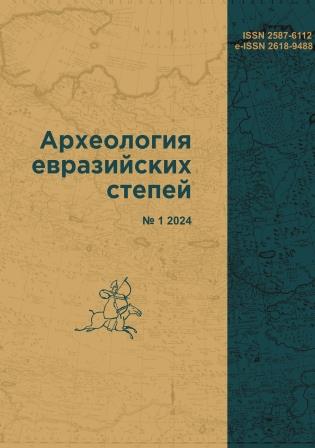Medieval Fabrics Acсording to the Texts of Birch-Bark Letters of the Second Third of the XIII – XV Centuries
DOI:
https://doi.org/10.24852/2587-6112.2024.1.169.176Keywords:
archaeology, Middle Ages, birch-bark letters, Novgorod, Pskov, fabrics/textiles, cubit, piece of cloth, dyeing and bleaching, weaving, textile tradeAbstract
The article presents the results of the study of Novgorod and Pskov birch-bark letters of the second third of the XIII – XV centuries, containing information about fabrics. The research includes an analysis of data on fabric length measures, textile dyeing and bleaching, range of fabrics and value of their certain types. Besides that, a special focus is given to the texts pointing out the local manufacturing of fabrics or their foreign origin. The most important data on fabrics mentioned in the birch-bark letters are compared with the pre-Mongol period. As a result of the analysis, it was found out that textiles common in Rus in the period from the second third of the XIII to the XV century were made of the same raw materials as in pre-Mongol times – wool, silk, flax and hemp; meanwhile the birch-bark letters indicate a variety of fabrics from the same raw material, and that was due to the differences in the quality of textile processing and its dyeing. At the same time information about the use of cotton fabrics appeared in the period under review, though such information was absent in the documents of the previous period. The study of birch-bark letters also showed that Rus fabrics were measured by cubits and by pieces of cloth, textiles were being dyed in different colors, and fabrics made from vegetable raw materials could be bleached. The fact of presence on the market of silk and cotton, which were imported fabrics, confirms the existence of economic relations of Rus with other countries. Besides, birch-bark texts demonstrate that fabrics were involved in internal trade, they could be used for tax payment instead of money, as well as means of paying debts and compensating losses.
References
Artsikhovsky, A. V. 1954. Novgorodskie gramoty na bereste (iz raskopok 1952 g.) (Novgorod birch-bark letters (from the 1952 excavations)). Moscow: Academy of sciences of the USSR (in Russian).
Artsikhovsky, A. V. 1963. Novgorodskie gramoty na bereste (iz raskopok 1958–1961 gg.). (Novgorod birch-bark letters (from the 1958–1961 excavations)). Moscow: Academy of sciences of the USSR (in Russian).
Artsikhovsky, A. V., Borkovsky, V. I. 1958. Novgorodskie gramoty na bereste (iz raskopok 1953–1954 gg.). (Novgorod birch-bark letters (from the 1953–1954 excavations)). Moscow: Academy of sciences of the USSR (in Russian).
Artsikhovsky, A. V., Borkovskiy, V. I. 1963. Novgorodskie gramoty na bereste (iz raskopok 1956–1957 gg.) (Novgorod birch-bark letters (from the 1956–1957 excavations)). Moscow: Academy of sciences of the USSR (in Russian).
Artsikhovsky, A. V., Yanin, V. L. 1978. Novgorodskie gramoty na bereste (iz raskopok 1962–1976 gg.) (Novgorod birch-bark letters (from the 1962–1976 excavations)). Moscow: “Nauka” Publ. (in Russian).
Burov, V. A. 1978. In Shmidt, S. O. (ed). Arkheograficheskiy ezhegodnik za 1977 god (Archaeographic year-book for 1977). Moscow: “Nauka” Publ., 86–87 (in Russian).
Gippius, A. A., Zaliznyak, A. A. 2016. In Voprosy yazykoznaniya (Issues of linguistics) (4), 7–17 (in Russian).
Gippius, A. A., Sichinava, D. V. 2021. In Russkiy yazyk v nauchnom osveshchenii (Russian Language and Linguistic Theory) (2), 178–259 (in Russian).
Zaliznyak, A. A. 2004. Drevnenovgorodskiy dialekt (Old Novgorod dialect). Moscow: “Yazyki slavyanskoy kul'tury” Publ. (in Russian).
Zaliznyak, A. A., Kolosova, I. O., Labutina, I. K. 1993. In Rossiiskaia Arkheologiia (Russian Archaeology) (1), 196–210 (in Russian).
Levashova, V. P. 1966. Smirnov, A. P. (ed). Arkheologicheskii sbornik (Archaeological Papers). Series: Trudy Gosudarstvennogo istoricheskogo muzeya (Proceedings of the State Historical Museum) 40. Moscow: “Soviet Russia” Publ., 112–119 (in Russian).
Rybina, E. A. 1978. Arkheologicheskie ocherki istorii novgorodskoy torgovli X–XIV vv. (Archaeological sketches on the history of Novgorod trade in X–XIV centuries). Moscow: Moscow State University (in Russian).
Sreznevskii, I. I. 1912. Materialy dlya slovarya drevnerusskogo yazyka po pis'mennym pamyatnikam (Materials for the dictionary of the Old Russian language according to the written monuments) vol. 3. Saint Petersburg: Typhography of the Imperial Academy of Sciences (in Russian).
Cherepnin, L. V. 1969. Novgorodskie berestyanye gramoty kak istoricheskiy istochnik (Novgorod birch-bark letters as a historical source). Moscow: “Nauka” Publ. (in Russian).
Yanin, V. L., Zaliznyak, A. A. 1993. Novgorodskie gramoty na bereste (iz raskopok 1984–1989 gg.) (Novgorod birch-bark letters (from the 1984–1989 excavations)). Moscow: “Nauka” Publ. (in Russian).
Yanin, V. L., Zaliznyak, A. A. 2000. Novgorodskie gramoty na bereste (iz raskopok 1990–1996 gg.). (Novgorod birch-bark letters (from the 1990–1996 excavations)) vol. X. Moscow: “Russkie slovari” Publ. (in Russian).
Yanin, V. L., Zaliznyak, A. A., Gippius, A. A. 2015. Novgorodskie gramoty na bereste (iz raskopok 2001–2014 gg.) (Novgorod birch-bark letters (from the 2001–2014 excavations)) vol. XII. Moscow: “Yazyki slavyanskoy kul'tury” Publ. (in Russian).
Gramoty.ru: Drevnerusskie berestyanye gramoty (Old Rus birch-bark letters). Available at: =. (accessed 01.08.2023) (in Russian).

Downloads
Published
How to Cite
Issue
Section
License
Copyright (c) 2024 E.M. Kalugina

This work is licensed under a Creative Commons Attribution-NonCommercial 4.0 International License.







